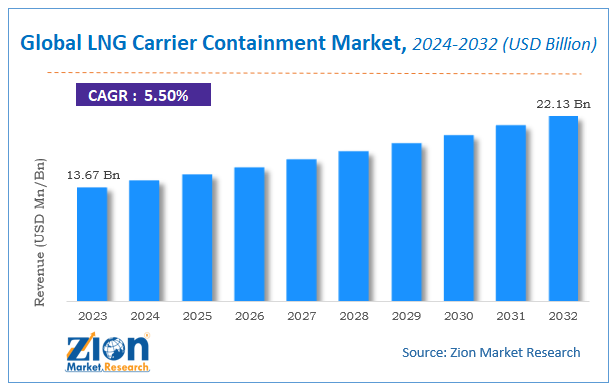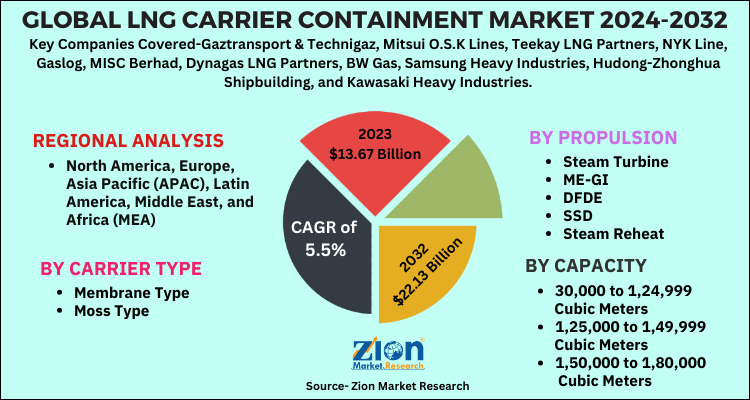LNG Carrier Containment Market Size, Share, Trends, Growth 2032

LNG Carrier Containment Market By Carrier Type (Membrane and Moss), By Propulsion Type (Steam Turbine, ME-GI, DFDE, SSD, Steam Reheat, XDF, TFDE, and Others), and By Capacity (30,000 to 1,24,999 Cubic Meters, 1,25,000 to 1,49,999 Cubic Meters, 1,50,000 to 1,80,000 Cubic Meters, and Above 1,80,000 Cubic Meters), and By Region - Global and Regional Industry Overview, Market Intelligence, Comprehensive Analysis, Historical Data, and Forecasts 2024 - 2032
| Market Size in 2023 | Market Forecast in 2032 | CAGR (in %) | Base Year |
|---|---|---|---|
| USD 13.67 Billion | USD 22.13 Billion | 5.5% | 2023 |
LNG Carrier Containment Industry Prospective:
The global LNG carrier containment market size was evaluated at $13.67 billion in 2023 and is slated to hit $22.13 billion by the end of 2032 with a CAGR of nearly 5.5% between 2024 and 2032.
LNG Carrier Containment Market: Overview
The increased demand for natural gas from a variety of industries, as well as the increasing number of residential and commercial applications of LNG, are the primary factors driving the market for LNG carrier containment. In addition, during the course of the recent past, there has been a meteoric rise in the demand for LNG as a fuel for automobiles. This has contributed to the strengthening of supportive government rules for cleaner fuel, which aim to minimize reliance on petroleum fuels.
The market for LNG carrier containment has benefited from technological developments that have been implemented for the purpose of making the liquefaction of natural gas more cost-effective and safe, as well as the transportation of LNG. However, the inconsistency of natural gas prices, the absence of infrastructure supportive of the liquefaction of natural gas, and the length of time needed for supply and acceptance of LNG in developing nations are all factors that could limit the market growth.
LNG Carrier Containment Market: Growth Factors
Liquefied natural gas, more popularly known as LNG, is a composition of methane and ethane to transfer natural gas to a liquid state for its easier and safe transportation. Liquefaction of natural gas enables its large-scale inter-continent transport after compression to a liquid state. LNG was previously introduced for convenient transportation of natural gas. Over the last few years, it has gained significant attention as an automobile fuel. LNG carrier containment is a tank ship specially designed for LNG transportation with properties to bear extraordinary tank pressure levels and prevent any type of gas contamination. The design and structure of the LNG cargo containment tank vary according to chemical and physical parameters of the gas, which depends on the varied needs of end-users. A typical LNG carrier containment comprises four to six tanks that are located along the vessel’s centerline.
The LNG carrier containment market is majorly driven by the rising demand for natural gas from various industries and LNG’s growing number of residential and commercial applications. Furthermore, LNG has witnessed an exponential increase in its demand as an automobile fuel in recent past, which has bolstered supportive government regulations for cleaner fuel that aims to reduce dependence on petroleum fuels. Technological advancements that were introduced for cost-efficient and safe liquefaction of natural gas and LNG transportation have also contributed to the LNG carrier containment market.
However, the volatility in prices of natural gas, the lack of supportive infrastructure for liquefaction of natural gas, and time-consuming delivery and reception of LNG in developing economies may restrain the market. Alternatively, the construction of new LNG export terminals in Australia is expected to fuel the LNG carrier containment market development in the years ahead.
In order to offer a comprehensive view of the global LNG carrier containment market, we have included a detailed value chain analysis. To understand the competitive landscape within the market, an analysis of Porter’s Five Forces model for the global LNG carrier containment market has additionally been included. The study includes a market attractiveness analysis, wherein all the segments are benchmarked based on their market size, growth rate, and general attractiveness.
The study also includes the market share of the key participants operating in the global LNG carrier containment market. Moreover, the report covers the strategic development in the market along with acquisitions & mergers, agreements partnerships, collaborations & joint ventures, and regional growth of key market players on a global basis.
LNG Carrier Containment Market: Segmentation
The global LNG carrier containment market is fragmented on the basis of carrier type, propulsion type, and capacity.
By carrier type, the market is segmented into moss type and membrane type. In 2018, membrane type held a major share of the global market and is expected to hold its foremost market position with a higher CAGR over the forecast period.
According to propulsion type, the LNG carrier containment market includes steam turbine, ME-GI, DFDE, SSD, steam reheat, XDF, TFDE, and others. Steam turbine segment dominated the global market in 2018 and is expected to hold its market position in the future as well.
On the basis of capacity, the global market comprises above 1,80,000 cubic meters, 1,50,000 to 1,80,000 cubic meters, 1,25,000 to 1,49,999 cubic meters, and 30,000 to 1,24,999 cubic meters. In 2018, the above 1,80,000 cubic meters segment held the largest market share globally.
LNG Carrier Containment Market: Report Scope
| Report Attributes | Report Details |
|---|---|
| Report Name | LNG Carrier Containment Market |
| Market Size in 2023 | USD 13.67 Billion |
| Market Forecast in 2032 | USD 22.13 Billion |
| Growth Rate | CAGR of 5.5% |
| Number of Pages | 174 |
| Key Companies Covered | Gaztransport & Technigaz, Mitsui O.S.K Lines, Teekay LNG Partners, NYK Line, Gaslog, MISC Berhad, Dynagas LNG Partners, BW Gas, Samsung Heavy Industries, Hudong-Zhonghua Shipbuilding, and Kawasaki Heavy Industries |
| Segments Covered | By Carrier Type, By Propulsion Type, By Capacity and By Region |
| Regions Covered | North America, Europe, Asia Pacific (APAC), Latin America, Middle East, and Africa (MEA) |
| Base Year | 2023 |
| Historical Year | 2018 to 2022 |
| Forecast Year | 2024 - 2032 |
| Customization Scope | Avail customized purchase options to meet your exact research needs. Request For Customization |
LNG Carrier Containment Market: Regional Insights
The regional segment includes North America, Latin America, Europe, Asia Pacific, and the Middle East and Africa.
The Asia Pacific region held the largest share of the LNG carrier containment market globally in 2018. Moreover, the region is expected to witness the fastest CAGR over the forecast time period.
LNG Carrier Containment Market: Competitive Space
Some major players in the LNG carrier containment market are
- Gaztransport & Technigaz
- Mitsui O.S.K Lines
- Teekay LNG Partners
- NYK Line
- Gaslog
- MISC Berhad
- Dynagas LNG Partners
- BW Gas
- Samsung Heavy Industries
- Hudong-Zhonghua Shipbuilding
- Kawasaki Heavy Industries.
This report segments the global LNG carrier containment market into:
Global LNG Carrier Containment Market: Carrier Type Analysis
- Membrane Type
- Moss Type
Global LNG Carrier Containment Market: Propulsion Type Analysis
- Steam Turbine
- ME-GI
- DFDE
- SSD
- Steam Reheat
- XDF
- TFDE
- Others
Global LNG Carrier Containment Market: Capacity Analysis
- 30,000 to 1,24,999 Cubic Meters
- 1,25,000 to 1,49,999 Cubic Meters
- 1,50,000 to 1,80,000 Cubic Meters
- Above 1,80,000 Cubic Meters
Global LNG Carrier Containment Market: Regional Analysis
- North America
- The U.S.
- Europe
- UK
- France
- Germany
- Asia Pacific
- China
- Japan
- India
- Latin America
- Brazil
- Middle East and Africa
Table Of Content
Methodology
FrequentlyAsked Questions
LNG (Liquefied Natural Gas) carrier containment is the system that is intended to ensure the secure storage and transportation of liquefied natural gas on LNG carriers. LNG is a liquid form of natural gas that has been chilled to a liquid state at a temperature of approximately -162°C (-260°F) to facilitate storage and transportation.
The demand for LNG carriers and advanced containment systems to transport LNG efficiently is driven by the growing global demand for greener energy sources and natural gas. The demand for LNG carriers with advanced containment systems is increased by the development of LNG infrastructure, which includes new liquefaction facilities, regasification terminals, and transportation networks.
The global LNG carrier containment market size was evaluated at $13.67 billion in 2023 and is slated to hit $22.13 billion by the end of 2032.
The global LNG carrier containment market a CAGR of nearly 5.5% between 2024 and 2032.
The regional segment includes North America, Latin America, Europe, Asia Pacific, and the Middle East and Africa.
Gaztransport & Technigaz, Mitsui O.S.K Lines, Teekay LNG Partners, NYK Line, Gaslog, MISC Berhad, Dynagas LNG Partners, BW Gas, Samsung Heavy Industries, Hudong-Zhonghua Shipbuilding, and Kawasaki Heavy Industries
RelatedNews
HappyClients
Zion Market Research
Tel: +1 (302) 444-0166
USA/Canada Toll Free No.+1 (855) 465-4651
3rd Floor,
Mrunal Paradise, Opp Maharaja Hotel,
Pimple Gurav, Pune 411061,
Maharashtra, India
Phone No +91 7768 006 007, +91 7768 006 008
US OFFICE NO +1 (302) 444-0166
US/CAN TOLL FREE +1 (855) 465-4651
Email: sales@zionmarketresearch.com
We have secured system to process your transaction.
Our support available to help you 24 hours a day, five days a week.
Monday - Friday: 9AM - 6PM
Saturday - Sunday: Closed







